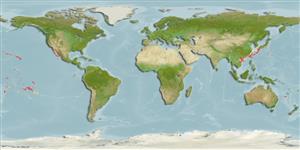>
Kurtiformes (Nurseryfishes, cardinalfishes.) >
Apogonidae (Cardinalfishes) > Apogoninae
Etymology: Apogon: Greek, a = without + Greek pogon = chin, beard (Ref. 45335).
More on author: Snyder.
Environment: milieu / climate zone / depth range / distribution range
Οικολογία
Θαλασσινό(ά) Υφαλόφιλο(α); εύρος βάθους 1 - 48 m (Ref. 58302). Tropical
Eastern Central Pacific: known only from the Hawaiian Islands and Johnston Island. Reports of occurrence in other Indo-West Pacific countries are questionable.
Μέγεθος / Βάρος / Age
Maturity: Lm ? range ? - ? cm
Max length : 4.0 cm SL αρσενικό/απροσδιόριστο; (Ref. 40822)
Ραχιαίες άκανθες (συνολικά): 7; Μαλακές ραχιαίες ακτίνες (συνολικά): 8-9; Εδρικές άκανθες 2; Μαλακές εδρικές ακτίνες: 8. Differs from other members of the A. erythrinus complex by having the following characteristics: from all others by having a much longer second dorsal fin spine, reaching to at least the base of third ray of second dorsal fin when depressed (spine in other species do not reach third ray); from A. indicus by having 14 pectoral fin rays (versus 13, rarely 12 or 14), and by lacking pigment on the dorsal surface of the caudal peduncle (present in A. indicus); from A. marquesensis by lacking scattered chromatophores on sides of caudal peduncle that extend anteriorly as a band from caudal fin base to vertical from ends of dorsal and anal fin rays (pigment extends forward as a band in A. marquesensis); from A. susanae by having pigment present on scale edges at front of second dorsal fin and sometimes along its base and scattered chromatophores on caudal fin base (absent in A. susanae) (Ref. 40822).
Found in shallow water and observed to be active only at night, near the bottom, and never far from its shelter (Ref. 27665). Benthopelagic (Ref. 58302).
Life cycle and mating behavior
Γεννητική Ωρίμανση | Αναπαραγωγή | Γεννοβολία | Αβγά | Γονιμότητα | Προνύμφες
Mouthbrooders (Ref. 240). Distinct pairing during courtship and spawning (Ref. 205).
Greenfield, D.W., 2001. Revision of the Apogon erythrinus complex (Teleostei: Apogonidae). Copeia 2001(2):459-472. (Ref. 40822)
IUCN Red List Status (Ref. 130435)
Threat to humans
Harmless
Human uses
Περισσότερες πληροφορίες
ΑναφορέςΥδατοκαλλιέργειεςΠροφίλ υδατοκαλλιέργειαςΣτελέχοιΓενετικήElectrophoresesΚληρονομικότηταΑσθένειεςΜεταποίησηNutrientsMass conversion
ΣυνεργάτεςΦωτογραφίεςStamps, Coins Misc.ΉχοιΣιγκουατέραΤαχύτηταΚολυμβητικός ΤύποςΕπιφάνεια βραγχίωνOtolithsΕγκέφαλοιΌραση
Εργαλεία
Special reports
Download XML
Διαδικτυακές πηγές
Estimates based on models
Preferred temperature (Ref.
123201): 23.8 - 28.2, mean 25.9 °C (based on 48 cells).
Phylogenetic diversity index (Ref.
82804): PD
50 = 0.5000 [Uniqueness, from 0.5 = low to 2.0 = high].
Bayesian length-weight: a=0.01479 (0.00690 - 0.03171), b=3.09 (2.91 - 3.27), in cm total length, based on LWR estimates for this (Sub)family-body shape (Ref.
93245).
Τροφικό Επίπεδο (Ref.
69278): 3.8 ±0.59 se; based on food items.
Ελαστικότητα (Ref.
120179): Υψηλό, ελάχιστος χρόνος για διπλασιασμό πληθυσμού < 15 μήνες (tmax=0.3 (120 days)).
Fishing Vulnerability (Ref.
59153): Low vulnerability (10 of 100).
Nutrients (Ref.
124155): Calcium = 952 [94, 19,045] mg/100g; Iron = 9.11 [1.05, 60.08] mg/100g; Protein = 18.2 [14.3, 21.9] %; Omega3 = 0.107 [0.003, 3.480] g/100g; Selenium = 460 [12, 14,566] μg/100g; VitaminA = 1.94 [0.02, 180.42] μg/100g; Zinc = 14.7 [2.5, 60.1] mg/100g (wet weight);
